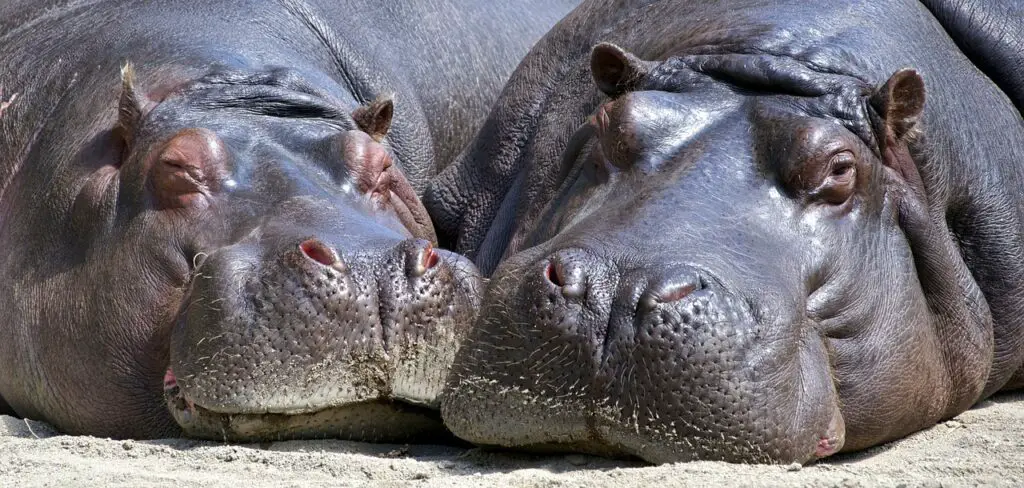How fast can a Hippo run? Let’s Know
Hippos are not known for their speed, but they are capable of running at a surprisingly fast rate for their size.
A hippo can run at speeds of up to 19-30 miles per hour (30-48 kilometres per hour) in short bursts over 330 feet on land (100 meters).
Hippos, on the other hand, are not built for long-distance running and can only maintain these high speeds for short distances.
They have much better swimming abilities and can travel long distances in water.
Hippos can actually hold their breath for up to 5 minutes and swim at speeds of up to 8 miles per hour (13 kilometres per hour).
Hippos are one of the world’s largest land animals, and their massive size gives them the appearance of being slow and lumbering. They are, however, quite agile and can move surprisingly quickly when necessary.
When a hippo runs, it gallops its legs, with both legs on one side of its body moving together first, followed by the legs on the other side. This is known as a “bound” gait, and it allows the hippo to move quickly over short distances.
Hippos usually only run when they are threatened or defending their territory or young.
They can be aggressive and territorial animals, so give them plenty of room if you come across one.
Overall, while hippos are not known for their speed, they are still impressive runners for their size and should not be underestimated.

Are Hippos faster in water or in land?
Hippos move much faster in water than on land. They can run at speeds of up to 19-30 miles per hour (30-48 kilometres per hour) on land, but they are much better adapted for swimming and can move much faster in water.
In fact, hippos are widely regarded as among the best swimmers in the animal kingdom.
They can swim at speeds of up to 8 miles per hour and can hold their breath for up to 5 minutes (13 kilometres per hour).
They can also move quickly through the water because of their streamlined bodies, powerful legs, and webbed feet.
Hippos spend a lot of time in the water, where they can hide from predators, regulate their body temperature, and socialise with other hippos.
They can also cover much greater distances in water than on land, making it an important part of their daily lives.
Although hippos can run on land, they are much more comfortable and efficient in the water. If you come across a hippo in the wild, give it plenty of space and respect its aquatic abilities.
Research that proves the running speed of Hippos
There have been several studies and observations that have documented the running speed of hippos.
Here are some examples:
1. A radar gun was used in a 2005 study published in the Journal of Zoology to record the running speed of captive hippos. Over short distances, the hippos could reach speeds of up to 19 miles per hour (31 kilometres per hour), according to the researchers.
2. Another study, published in the Journal of Mammalogy in 2011, used a GPS tracking system to measure the running speed of wild hippos in Tanzania. The hippos could run at speeds of up to 14 miles per hour (22 kilometres per hour) over distances of up to 300 feet, according to the researchers (91 meters).
3. In a 2017 study published in the Journal of Experimental Biology, researchers used high-speed cameras to analyse hippos’ running gait. They discovered that hippos run with a bounding gait, allowing them to generate a lot of force and reach high speeds over short distances.
4. Hippos in the wild have also been observed to have impressive running abilities. A group of hippos, for example, can be seen charging at a group of lions to protect their young in a video captured by the BBC’s “Planet Earth” series. Hippos can cover a distance of about 100 metres in a matter of seconds.
5. A hippo’s running speed can be affected by its size and weight. Larger hippos move faster than smaller ones, and male hippos, which can weigh up to 3,500 pounds (1,600 kilograms), move faster than female hippos, which typically weigh around 2,500 pounds (1,100 kilograms).
6. Hippos can run on a variety of surfaces, including grass, mud, and rocky terrain. They prefer soft, muddy terrain because it provides more traction and cushioning for their joints.
7. Hippos are known for their aggressive nature, and their ability to run at high speeds makes them even more dangerous when threatened. Hippos will often charge at intruders, including humans, in the wild to protect their territory or young.
8. Despite their impressive running speed, hippos are not built for long distances and are better suited to swimming. They can swim at high speeds for longer distances, and their bodies are perfectly designed for efficient water movement.
Hippos are not the quickest animals in the animal kingdom, but when they have to be, they can move at astonishing rates across short distances. They are formidable opponents on land and in the sea due to their massive, strong physique and aggressive nature.
Can a man outrun a Hippo?
No one can outrun a hippo. Hippos have incredible speed and can run at speeds ranging from 19-30 miles per hour (30-48 kilometres per hour) in short bursts.
In comparison, the average human can run at peak speeds of 8-10 miles per hour (12-16 kilometres per hour).
Hippos are known for their aggressiveness and territorial behaviour, in addition to their speed.
They kill more people in Africa than any other large animal, and their large size and sharp teeth make them a dangerous enemy.
If you come across a hippo in the wild, give it plenty of space and avoid provoking it in any way. Trying to outrun a hippo is not an option; instead, retreat slowly and calmly to a safe distance.
While humans are capable of many amazing physical feats, outrunning a hippo is not one of them.
It is critical to respect these incredible animals’ strength and speed, as well as to provide them with the space they require to live and thrive in their natural habitats.

What makes Hippos faster in water than on land? ANSWERED
There are several factors that make hippos faster in water than they are on land. These include:
1. Streamlined body shape: Hippos have streamlined, torpedo-shaped body that is perfectly adapted for swimming. This shape reduces drag and allows the hippo to move through the water more efficiently.
2. Webbed feet: Hippos have webbed feet that act as paddles in the water, providing additional propulsion. This enables them to move quickly and change directions with ease.
3. Strong leg muscles: Hippos have strong leg muscles that make them ideal for swimming. They propel themselves forward in the water with their legs, much like a human swimmer does with their arms and legs.
4. Buoyancy: The hippo’s large, heavy body is buoyant in water, requiring less energy to move. Swimming is now easier and more efficient than running on land.
5. Hydrodynamic skin: Hippos have thick, oil-secreting skin that helps to reduce drag and increase their speed in the water.
Hippos are generally well adapted for life in the water, and they are exceptionally fast and agile swimmers thanks to their streamlined body, strong leg muscles, and webbed feet.
They can run on land as well, but they prefer the comfort and efficiency of swimming, where they spend the most of their time.
How long can Hippos run for?
Hippos are not built for long-distance running and can only maintain high speeds for short bursts of about 330 feet (100 meters). They quickly tyre after that and are forced to slow down or stop.
Hippos are better adapted to swimming than running in general, and they can travel much farther in water than they can on land.
They can swim at speeds of up to 8 miles per hour (13 kilometres per hour) and can hold their breath for up to 5 minutes, allowing them to travel long distances through rivers and lakes.
When hippos run on land, they usually do so in short bursts to avoid predators or to defend their territory or young.
They can reach speeds of up to 19-30 miles per hour (30-48 kilometres per hour), but can only maintain these speeds for a few seconds before tiring.
Overall, while hippos can run at high speeds, they are not built for long distances and are much more comfortable and efficient in water.
They are one of the most fascinating and formidable animals in the animal kingdom due to their large, powerful bodies and strong swimming abilities.
